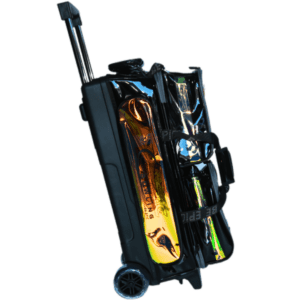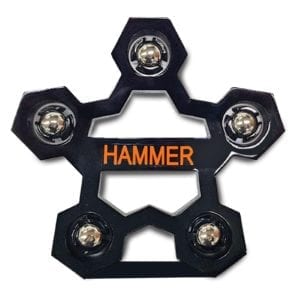Bowling News, Bowling Videos, Editorials
What are the Hardest Splits in Bowling?
Is it the 7-10 Split? The Greek Church? The Big Four?
The dreaded 7-10 split is by many accounts the toughest shot in bowling. WIRED’s Robbie Gonzalez went to the U.S. Bowling Congress to meet a pro bowler, an engineer, and a robot named Earl, to find out why it’s actually Almost Impossible.
On the first shot of any given frame, a pro is more likely than not to send all ten pins clattering to the deck, whereas a layperson is liable to leave some standing in one of the more than 1,000 patterns—aka spare configurations—that leftover pins can occupy.
The pros can convert many of those configurations with ease, but some pin arrangements pose such a challenge that experts and novices stand an equally dismal chance of success. Among the most notorious spares is the 7-10 split, which seasoned bowlers talk about with a kind of battered reverence.
“I’ve been bowling since I was 10 years old. Today I’m 42, I’ve been bowling professionally for going on 20 years, and I’ve made the 7-10 three times,” Malott says. He estimates he’s made hundreds, if not thousands, of attempts at it, so when I ask him to actually demonstrate why that spare is so difficult, he obliges somewhat begrudgingly.
In the 7-10 split, only the two outermost pins are left standing. (Picture the posts on a bed the width of a twin mattress, and you’ll have a rough idea of the space between the two pins.) “You’re sending one pin over to try and pick up two,” Malott explains, between failed attempts. “And that one pin has to bounce, fall, and spin the right way to hit the other.”
But unlike every other spare configuration, you can’t convert the 7-10 split with ball and pins alone. That’s because doing so would require hitting either pin on the outermost point of its radius. The problem: It’s impossible to get a bowling ball into that position without it first falling into the gutter. To successfully convert the 7-10 split, you need to rebound one of the pins off the pinsetter—the machinery that clears the lane of fallen pins and returns them to their appropriate positions.
Between the bowling pin’s funny shape and the mechanical variability of pinsetters, no bowler on Earth can ricochet a pin reliably. “You need some kind of lucky bounce,” says Tom Frenzel, a USBC research engineer. “It hasn’t got anything to do with your skill, you just have to throw it hard and fast and hope you get it.” The results are pretty underwhelming. On average, professional bowlers manage to convert the 7-10 split just 0.7 percent of the time, or about once every 145 attempts.
So that settles it, right? The 7-10 Split: Toughest spare in bowling. Not so fast.
“Everyone talks about the 7-10 split being the hardest shot in bowling. I wanted to know whether that was true,” says data journalist Ben Blatt. In 2015, he analyzed nearly half a million frames from professional bowling matches in search of the least-converted spares. When he finished running the numbers, he found another spare that elite bowlers convert just 0.3 percent of the time. It’s called the Greek Church.
When I share these numbers with Malott, he agrees the Greek Church is a doozy. But more difficult than the 7-10? Absolutely not. To prove his point, he takes a break from trying to convert the 7-10 split to attempt the Greek Church. He struggles a bit (it is, in fact, a very difficult spare to make), but manages to clean it up after about a dozen attempts, and very nearly does so another three or four times. Conversely, in almost two hours of bowling, Malott never came close to making the 7-10.
So why, in Blatt’s analysis, did players convert the Greek Church less often? The answer boils down to strategy.
To resolve the Greek Church, you need to hit all the pins on one side while sending at least one of them across the lane to knock over the remaining pins. It’s a highly technical—and highly risky—shot. If you miss, which is likely, you earn fewer points than if you simply go for the three pins you’re confident you can hit.
Bowlers call the second strategy going for count, and they typically opt for it when they encounter difficult spares. On the Greek Church, the two shots require different angles of attack. But on the 7-10 split, it’s effectively the same shot whether you’re trying to knock over one pin or two. “Blatt’s study was great, but his one blind spot was not accounting for whether the pro was actually attempting the split,” Frenzel says.
In other words: Hidden in the raw statistics is an important distinction between the rarest shot in bowling and the most difficult shot in bowling. And yet, both are plenty tough to convert, which gives athletes like Malott all the more reason to try to only bowl strikes.
Have you ever made the 7-10 split? Drop us a comment below!
































































I made the 7-10 once but didn’t see it. I turned around and heard everyone cheering. I hit the 7 pin and it bounced across and flipped forward knocking the 10 out.
My friend Duke was so angry that he had left a “pocket 7-10” that he just went to the line and chucked the ball at the 10-pin, then turned on his heel and stalked back to the score table. But while he was angrily walking back, the 10-pin popped out of the pit and converted the spare! So he can claim to have converted the 7-10… he just didn’t see it happen!
Tonight I made the 7-8-10 split in a varsity match and everyone started screaming. Honestly, I figured there was no way I would make it.